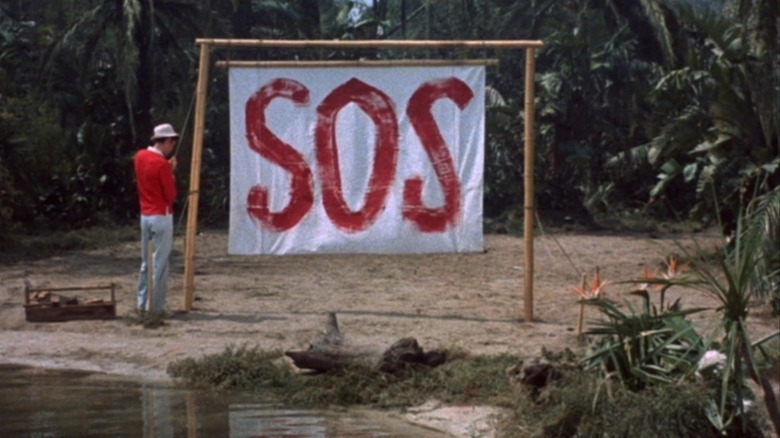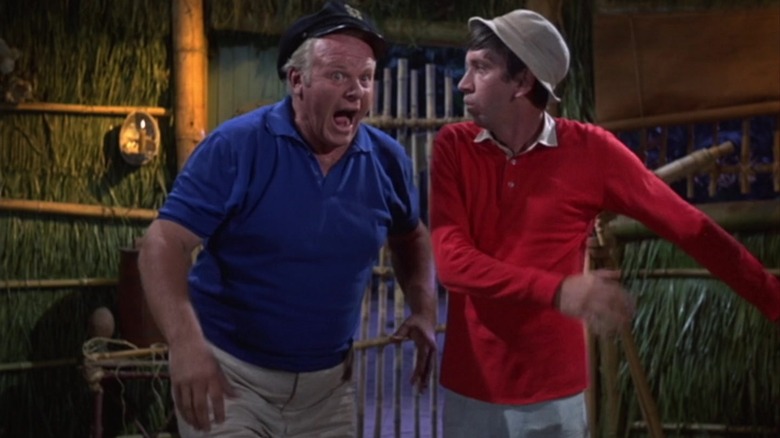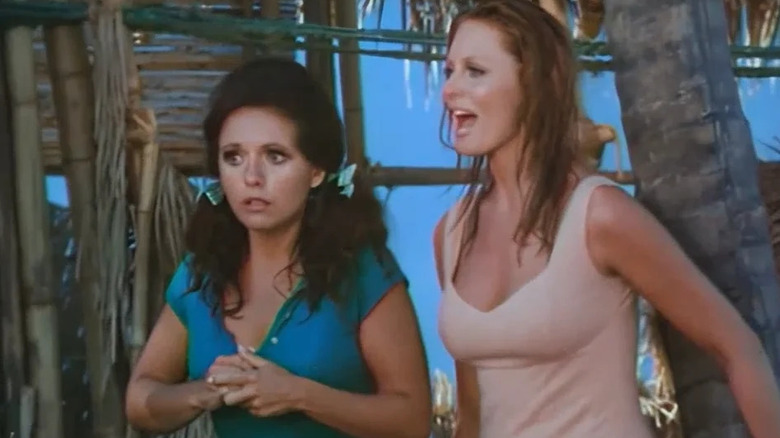
Thanks to the earworm that is “The Ballad of Gilligan’s Island,” most audiences know how Gilligan (Bob Denver) and the other castaways became stranded. Gilligan and the Skipper (Alan Hale) took five passengers on an intended three-hour tour of the Hawai’ian islands when they hit rough weather and were thrown off-course. The ship set ground on the shore of an uncharted desert isle, and the seven castaways had to learn to survive. Because “Gilligan’s Island” was broad and cartoonish, however, the survival was never harrowing or even particularly difficult. There were rarely food or water shortages, and everyone brought huge amounts of clothes and supplies. Life actually seemed okay on Gilligan’s Island, the utter isolation notwithstanding.
Series creator Sherwood Schwartz said that he intended “Gilligan’s Island” to be an idealized microcosm of a well-functioning American democracy. Seven character, all from different classes, are forced to live together by extreme circumstances, but they managed to survive, thrive, and get along without killing each other. To Schwartz, “Island” was an optimistic series.
Of course, in its structure, “Gilligan’s Island” is also a portrait of Sisyphean futility. At the beginning of every episode, an object or person appears on the island, offering the castaways a potential avenue for escape. The Professor (Russell Johnson) designs their escape route, and the hearts of the castaways fill with hope. Then, like a cosmic agent of fate, Gilligan bumbles the escape, and the castaways once again sink into despair. Hope is fleeting; our own foibles and cluelessness keep us trapped.
The series was never given a proper ending, either. After three seasons and 98 episodes, the castaways never actually escaped. Their escape wouldn’t come until a 1978 TV movie, and even then, it was only temporary. In that sense, there were multiple endings to “Gilligan’s Island.”
The original Gilligan’s Island didn’t have an ending
The final episode of “Gilligan’s Island” was called “Gilligan, the Goddess” (April 17, 1967), and its story was as typical as any episode to come before it. A neighboring king from a nearby island seeks a young woman to sacrifice to the volcano gods (gotta love that 1960s cultural sensitivity), so the castaways dress Gilligan in drag and offer him in her staid. There is nothing epic or significant about that episode’s story that would indicate the series was coming to an end.
Indeed, the showrunners assumed “Gilligan’s Island” would be picked up for a fourth season. Instead, it was pulled from CBS’s calendar at the last minute.
Speaking in a 2013 interview with Esquire, Mary Ann actor Dawn Wells recalled how the long-running supra-hit “Gunsmoke” had ben canceled, and the plan was for “Gilligan’s Island” to move into its time slot. However, from what she understood, one of the top executives at CBS pushed to cancel “Gilligan’s Island” instead of “Gunsmoke” at the insistence of their spouse, who loved the latter series. “[Barbara] Paley — the wife of the board chairman [William S. Paley] — had been on vacation when ‘Gunsmoke’ was canceled, and when she got home, she said, ‘You can’t cancel ‘Gunsmoke.’ It’s my favorite show.’ So they canceled us,” Wells explained. In the end, Schwartz’s show was taken off the air while “Gunsmoke” persisted until 1975.
As /Film has written about before, the cancelation of “Gilligan’s Island” was also the result of the then-new CBS president James T. Aubrey canceling “Gunsmoke” because ratings were flagging and it was long in the tooth after 12 years. William S. Paley, a longtime champion of “Gunsmoke,” forced Aubrey to un-cancel the show, allowing the stars to renegotiate their contracts and ask for more money. The increased budget for “Gunsmoke” forced CBS to cut corners elsewhere, so “Gilligan’s Island” was nixed.
And so it went. “Gilligan’s Island” never got a proper ending and moved into eternal syndication, airing reruns for years.
Rescue from Gilligan’s Island finally saw the castaways off the island for the first time
Thanks to those reruns, though, “Gilligan’s Island” remained a big hit. Schwartz’s series was never a critical success, but it was a pretty powerful ratings bonanza. The ratings stayed high in reruns, and the show was seen, time and time again, throughout the 1970s. By 1978, interest was still high, and audiences were finally invested in the plight of the castaways.
Fans’ concerns would finally be addressed in the 1978 TV movie “Rescue from Gilligan’s Island,” an event meant to wrap up the story from “Gilligan’s Island.” The show’s cast returned, save for Tina Louise (Ginger), who was replaced by Judith Baldwin. “Rescue” catches up with the castaways after they had been stranded for 15 years. When a radioactive piece of a Soviet satellite lands on the island, the Professor converts it into a barometer … only to discover that a storm is coming, big enough to destroy the island. In a last-ditch effort, the castaways lash their cabins together to create a makeshift sea vessel.
The vessel drifts out to sea, is spotted by a passing ship, and the castaways are rescued. They return to the mainland … only to find that a lot has changed. Mary Ann is aiming for an unhappy marriage, the Professor cannot go back to his professorship because of his celebrity, and the Skipper gets bogged down in an insurance rigmarole over the fate of the S.S. Minnow. Also, there are Russian spies following everyone, hoping to locate their radioactive satellite piece.
It seems that being rescued didn’t really make the castaways terribly happy. When the insurance payment finally comes through, the castaways reunite on board the S.S. Minnow II to celebrate. Sadly, the Minnow II’s compass is broken, and when it hits bad weather, it’s thrown off course. The movie ends with the castaways landing back on the exact same island, stranded once again.
The ending of “Gilligan’s Island” was going to be a big cosmic joke.
The many times the castaways returned to Gilligan’s Island
“Rescue” was popular enough, however, to get a 1979 sequel called “The Castaways of Gilligan’s Island,” which also took our seven heroes back to the mainland. It seems that the storm from the previous TV movie uncovered a secret U.S. Army airport hangar that was always on the island (!), so the Professor builds a working plane from the machines inside. The plane ends up accidentally dropping Gilligan, forcing the castaways to crash-land back on the island, but their flight gets the attention of the U.S. Navy. The island is finally mapped and made a U.S. territory, and the castaways are saved for good.
The second half of the TV movie was intended to be a pilot for a “Fantasy Island”https://www.slashfilm.com/”Love Boat”-style series wherein the Howells open a beach resort on their old island, with guest starts regularly visiting to get advice on their love lives. (In Sisyphean terms, they made their rock “their thing.”) Now located and happy to live on a beach, it seemed that the castaways’ adventure was finally at an end.
“The Castaways of Gilligan’s Island,” however, never gave rise to an actual series.
In 1981, the final live-action Gilligan adventure took place, and it was the weirdest one yet. “The Harlem Globetrotters on Gilligan’s Island” sees the title basketball team crashing on the castaways’ beach resort. At the same time, a rival of Mr. Howell dupes the young Thurston Howell IV (David Ruprecht) into signing away the rights to the resort. To win it back, the Globetrotters have to win a game against the rival’s basketball team, which is made up of robots.
Yes, it’s real.
There were two animated “Gilligan’s Island” spinoffs as well, but those aren’t typically considered canon. One of the shows takes the castaways to a distant planet (!), where they interact with aliens. When “Gilligan’s Planet” was canceled in 1983, however, that was the last anyone heard from the castaways.
At least, until their 1987 guest spot on the sitcom “ALF.” The “ALF” appearance implied that the castaways were stranded once again and still longed for civilization. It seems rescue will never be permanent for them.





Leave a Reply